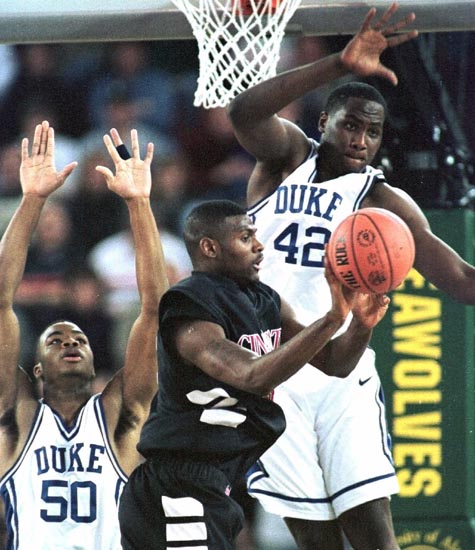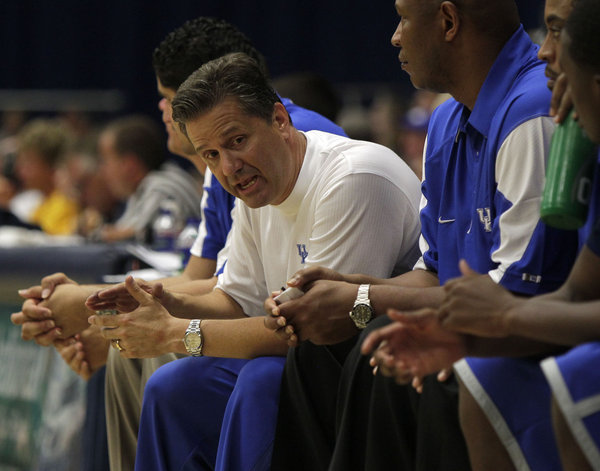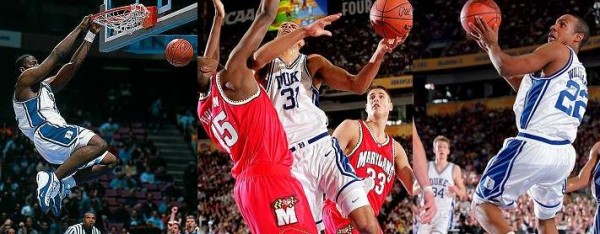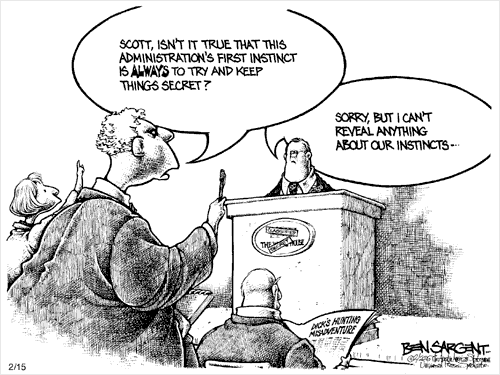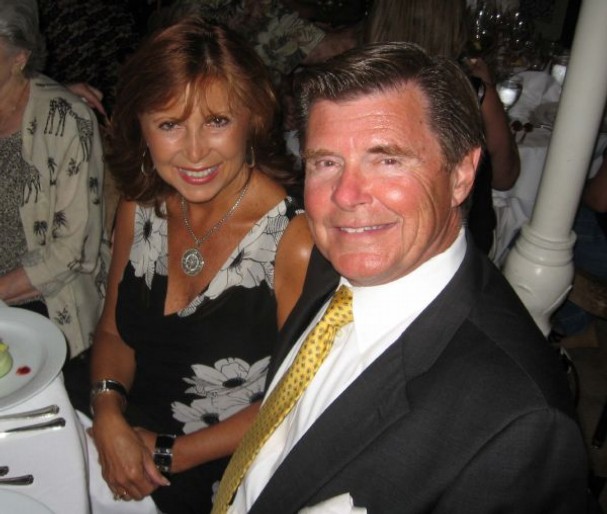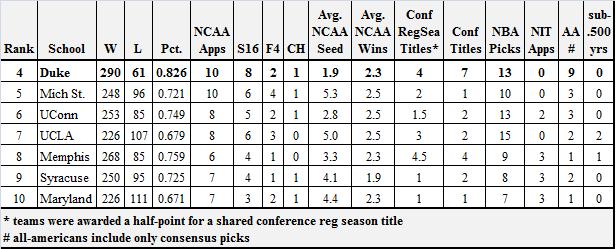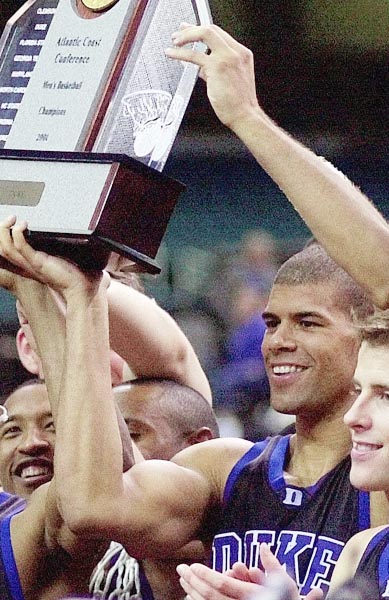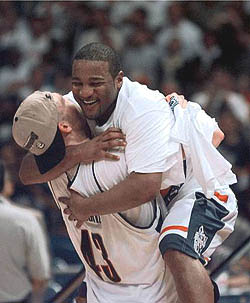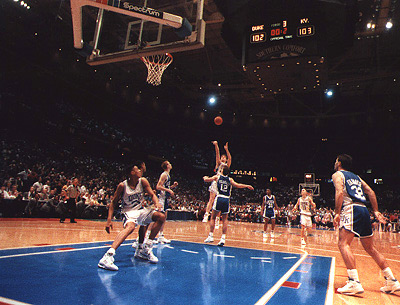Posted by nvr1983 on March 27th, 2009
 We’ll be doing a full BGtD today so you won’t have any interruptions in coverage tonight. Honestly, last night’s games were kind of disappointing. Pittsburgh–Xavier was entertaining, but that was the only game that I would say was memorable from a pure basketball standpoint. Now the other games did have their own interesting subplots. UConn rolled over Purdue in a game that was close at points in the 2nd half, but I never really got the sense that the Huskies were in any danger of losing. I was particularly impressed with how the Huskies played despite the media circus that is going on around them. Missouri‘s victory over Memphis was entertaining although for me it was marred a little by the atrocious free throw shooting. As we mentioned last night, I really wonder what John Calipari does, if he does anything, for his team’s free throw shooting. At this point, I’m convinced J.J. Redick would have shot 70% from the free throw line if he had gone to Memphis. Also, what happened to vaunted Memphis defense. Missouri has a good offense, but they shouldn’t be able to hit triple digits in regulation against a team that went into the game with the #1 defense according to the Pomeroy numbers. I’m sure some of you took great pleasure in watching Villanova pick apart Duke leading to another early March exit for Coach K, but the game wasn’t exactly exciting if you didn’t have a rooting interest for (or in most people’s case against) a team.
We’ll be doing a full BGtD today so you won’t have any interruptions in coverage tonight. Honestly, last night’s games were kind of disappointing. Pittsburgh–Xavier was entertaining, but that was the only game that I would say was memorable from a pure basketball standpoint. Now the other games did have their own interesting subplots. UConn rolled over Purdue in a game that was close at points in the 2nd half, but I never really got the sense that the Huskies were in any danger of losing. I was particularly impressed with how the Huskies played despite the media circus that is going on around them. Missouri‘s victory over Memphis was entertaining although for me it was marred a little by the atrocious free throw shooting. As we mentioned last night, I really wonder what John Calipari does, if he does anything, for his team’s free throw shooting. At this point, I’m convinced J.J. Redick would have shot 70% from the free throw line if he had gone to Memphis. Also, what happened to vaunted Memphis defense. Missouri has a good offense, but they shouldn’t be able to hit triple digits in regulation against a team that went into the game with the #1 defense according to the Pomeroy numbers. I’m sure some of you took great pleasure in watching Villanova pick apart Duke leading to another early March exit for Coach K, but the game wasn’t exactly exciting if you didn’t have a rooting interest for (or in most people’s case against) a team.
The line-up for tonight should give us a couple of interesting games:
- 7:07 PM: #12 Arizona vs. #1 Louisville
- 7:27 PM: #3 Syracuse vs. #2 Oklahoma
- 9:37 PM: #3 Kansas vs. #2 Michigan State
- 9:57 PM: #4 Gonzaga vs. #1 UNC
We’ll be back around 7 for the start of tonight’s action. Leave your comments/questions and we’ll respond to them as soon as we start.
6:55 PM: A couple quick pieces of news to pass along in the midst of this Billy Gillispie madness and these somewhat important games tonight. Clemson‘s star forward Trevor Booker will return for his senior year. The news out of Iowa isn’t as good after Jake Kelly, Jeff Peterson, and David Palmer announced that they are transfering, which means that Todd Lickliter will need to replace 2 starting guards and a reserve forward.
7:10 PM: Chase Budinger makes a great play to temper Louisville’s great start. He’s going to need to have a great game tonight. If both teams use the press tonight, we’re going to get a blowout (and I think it will end up going in Louisville’s favor).
7:12 PM: I should warn you that I’m a big Chase Budinger fan so you’ve been warned. I haven’t seen a lot of him this year (stupid west coast starts), but I think he has the makings of a very solid NBA player.
7:14 PM: That’s not a good stat for Arizona. Only 6 Wildcats have scored in the NCAA tournament.
7:19 PM: Great play by Edgar Sosa feeding it to Preston Knowles. This pressure is going to kill Arizona if they only go 6 deep.
7:28 PM: I don’t think it will matter tonight, but I hope you paid attention to that FT statistic. Louisville shoots 63.8% as a team (307th out of 334 teams). That will come back to bite them. Just ask John Calipari. Actually he probably wouldn’t admit it because his team was just as bad last night. . .
7:30 PM: I think that any Blue Devil who mentions that they made the 1994 title game should put an asterisk by it on their resume saying that they rode Grant Hill‘s coattails there. If you don’t agree with me, see what happened the next year even if Coach K missed the last 2/3 of the season.
7:31 PM: It looks dead in Memphis. What do you guys think? I’m guessing it’s only 20% full. UNC fans must have bought up most of the stadium.
Read the rest of this entry »
| boom goes the dynamite
| Tagged: alabama, anthony grant, arinze onuaku, arizona, austin daye, austin johnson, bill james, bill self, billy donovan, billy gillispie, billy packer, blake griffin, bobby frasor, bobby knight, boom goes the dynamite, brady morningstar, chase budinger, chris paul, clark kellogg, clemson, coach k, cole aldrich, corey maggette, david palmer, duke, dwayne wade, edgar sosa, elton brand, eric devendorf, georgetown, gerald henderson, gonzaga, grant hill, greg monroe, iowa, jake kelly, jeff capel, jeff goodman, jeff peterson, jeremy pargo, jim boeheim, jim nantz, jj redick, jodie meeks, john calipari, jonny flynn, kalin lucas, kansas, kentucky, kobe bryant, lebron james, longar longar, louisville, mark few, memphis, michigan state, missouri, oklahoma, patrick patterson, pittsburgh, preston knowles, purdue, raymar morgan, rick barnes, rick pitino, roy williams, sherron collins, syracuse, taylor griffin, todd lickliter, tom izzo, tony crocker, travis ford, travis walton, trevor booker, tyler hansbrough, tyrel reed, tyshawn taylor, uconn, unc, villanova, wayne ellington, will avery, willie warren, xavier
Share this story






























